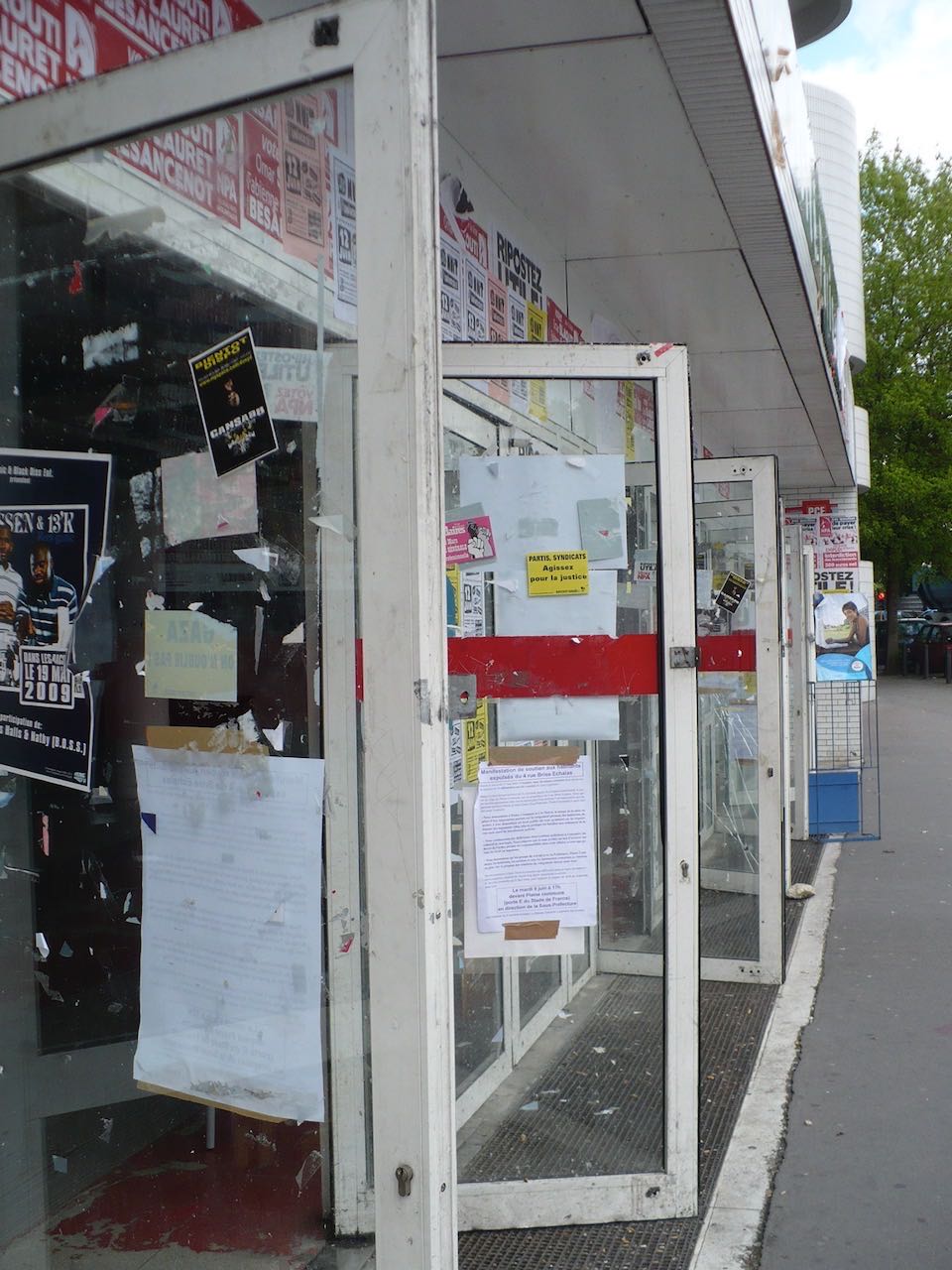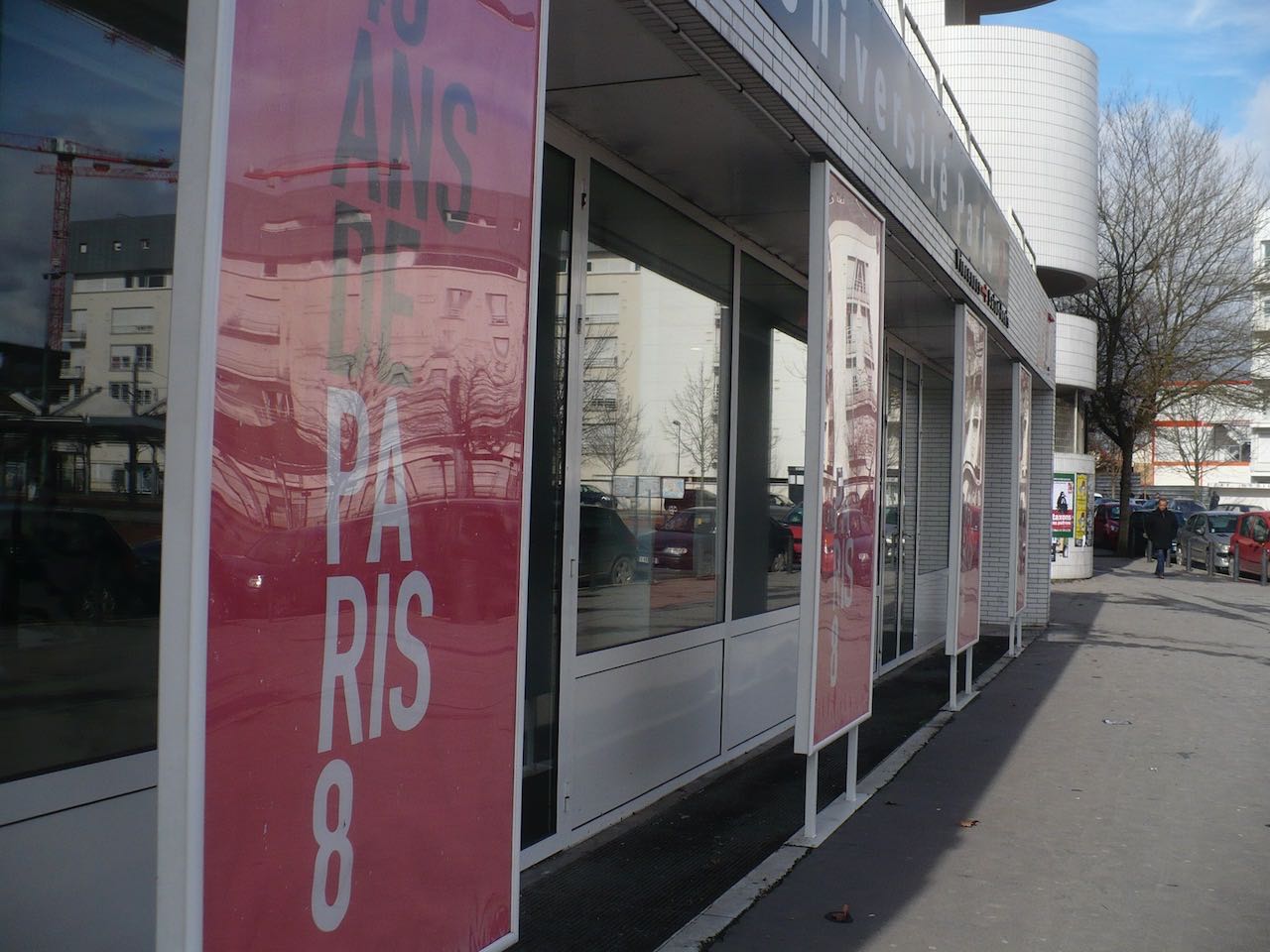By the time of my arrival in France, radical nostalgia for Vincennes had become a major source of ambivalence across the Paris 8 campus. Student radicals, and even some professors, denounced the stream of 1960s reminiscences. “I rapidly perceived that the ritual invocation of Vincennes and of the Great Ancestors was serving as a screen for some pretty sorry clannish practices,” commented a disenchanted former professor in 2009 (Brossat and Rogozinski 2009:17). The growth of historical self-consciousness only amplified a local culture of disappointed utopianism.

This became vividly apparent in the politics of campus space. When I first arrived at Paris 8 in June 2009, just at the end of a nation-wide university protest movement (Rose 2014), the entryway of the university showed marks of large-scale militancy. A huge pile of chairs was left over from a blockade, militant slogans like “long live the armed struggle” dotted the walls, and the glass doors to the hall were cracked and tattered. But when I came back in the autumn, the entry hall had been closed down, and construction crews were at work. They painted over the graffiti, replaced the cracked glass doors with a glass wall, and installed display cases just in time for the university’s 40th anniversary.

When the construction work was done, the former entrance hall had become an art gallery, with potted plants, glossy posters, a film screening room and track lighting; it was decorated in the campus’s official colors, black and red, rich in militant connotations. The first exhibit to occupy the space was called “From Vincennes to Saint-Denis: An alphabet,” a retrospective exhibit on the university’s history that had 27 alphabetically named panels, from Autonomie to Zizanie by way of Expérimental, Imaginaire, Populaire, and so forth.[37] I felt an immediate sense of irony when I saw how the built environment had been transformed. The political present had been effaced by a nostalgic image of the political past. A chaotic, living political space had been turned into a guarded memorial to 1968.
In theory, the exhibition celebrated the university’s anti-hierarchical project. “We had pulverized the sacred image of the Professor,” one text reflected. But in practice, the exhibition was useful to the extant hierarchy. I saw the campus president getting his portrait taken in the exhibit hall. Meanwhile, most student activists of my acquaintance denigrated the exhibition. “The revolution wrapped in cellophane,” one student called it.
The exhibition prominently featured the Great Men of the Philosophy Department. Daniel Bensaïd, the estwhile Trotskyist leader from 1968, contributed a melancholy text entitled “Resistance.”
Resisting the irresistible.
One can only forgive the unforgivable, the philosopher said.
In the same way, perhaps, one can only resist the irresistible.
Resistance is indissociable from that which sets itself up as its obstacle, and thus from death, which is its ultimate obstacle. I resist, therefore I am. To the point of agony.
…To resist is always to resist “that which one fears one cannot resist.” Resistance is not a commandment, an assignment, a designation to some sublime mission. It is always threatened with remaining in the grip of that which it resists, of bearing its marks, of accepting its subaltern status. There is, however, an unconditional refusal in the act of resistance, an ancient tensing of the back of the neck that refuses to bend, an “experiment in freedom” and in courage.[38]
It was a deeply citational text. The first line is a riff on Jacques Derrida’s argument that “one can only forgive the unforgivable,” quickly followed by the Cartesian joke that “I resist, therefore I am.” Repainted here in red and black, Descartes’ argument about thought got twisted in a quite bodily direction. Resistance became a “tensing of the back of the neck,” a matter of “not bending” in the face of “the grip” of the status quo, of processing one’s fear of acquiescence, even of encountering one’s “agony.”
Bensaïd himself died the month before the exhibition opened.
But not everyone in this milieu felt the same agonies. Agony, like resistance, proved to be deeply gendered. We have just seen how, after 1968, the loss of revolutionary hopes led into a period of philosophical radicalism that was increasingly depoliticized and somewhat defensive. Let us now examine the spaces of gender, power and exclusion that organized the Department’s space.
-
There were 27 instead of 26 panels in the exhibition because M (Monde) occupied two panels. ↩
-
The text appears to be a recycled and modified version of Bensaid’s 1998 interview with Françoise Proust, called “Résister à l’irrésistible.” See http://danielbensaid.org/Resister-a-l-irresistible?lang=fr, consulted Nov. 12, 2013. ↩